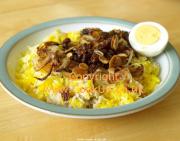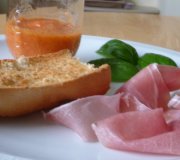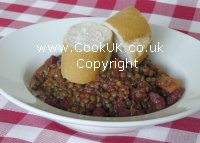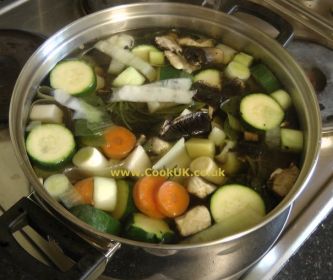INTRODUCTION
The key elements to a healthy soup are first and foremost the ingredients followed by the method used to cook the soup. Two other elements are important for soup and these are the cost and the dietary benefits. Each of these is examined in detail below.SOUP INGREDIENTS
Almost any food ingredient can be included in a soup so all the normal dietary rules apply to soups as they do to all other foods. However, the base of almost all soups is a stock and the ingredients in the stock are key not only to the flavour of the soup but also to how healthy the soup is.The main stock types are meat based stocks (e.g. lamb, beef), chicken stock and vegetable stock. There are other types as well, such as fish stock, but they are not so common. You have two choices when making a stock and they are stock cubes, or cook your own. No prizes for guessing which is the healthiest and the most tasty, cooking your own wins every time. However, it will take longer to cook your own compared to stock cubes.

Let's examine what is in commonly sold stock cubes to illustrate how healthy they really are. To do this we have assumed that the average main meal soup will have 250ml / roughly one cup / just under half a pint of stock in it. We are also using stock cubes which are on sale in late 2011 to early 2012.
Now let's look at some well known chicken stock cubes for example, you might think that they are chicken based but you would be severely wrong! In fact they contain 2% of chicken fat (the mind boggles at the thought of chicken fat) and 63% of concentrated chicken stock which consists principally of water! That's the only association they have with chicken. The top ingredient as far as the nutrition label is concerned is salt.
Other ingredients include
The other main brand of stock cubes are no better, although they don't put the % of ingredients on their packs it's clear that, for beef stock, there's almost no beef in their stock cubes. Way down their list of ingredients beef fat and dried beef bonestock are mentioned. As far as salt goes, they are only slightly just under the amount in the other stock cube.
The much advertised Stock Pots, as endorsed by Marco Pierre White, might seem a better option to the uninformed? Sorry to disappoint you but the pack says each stock pot (enough for 500ml of soup stock) contains 2% of chicken fat and only 0.2% of chicken powder - even less chicken compared to the stock cube! The salt content is even higher compared to any of the stock cubes.
In summary, our opinion of stock cubes is that they are not healthy at all when compared to a homemade stock.
COOKING YOUR OWN STOCK
In most households which regularly use vegetables there will be good quality vegetables left over and these are ideal for making good quality stock of any kind. Meat carcasses (chicken, lamb, beef, turkey) are also excellent ingredient for meat / poultry stocks. The mix of vegetables is almost irrelevant as long as there are three or more different ones. The only vegetable which is not good for many stocks is the humble potato. The reason is that potatoes will thicken the stock and in most cases this is not what is required.Other ingredients for a good stock are herbs such as rosemary, basil, oregano, sage, bay leaf and parsley. Dried herbs are fine but if you are lucky enough to grow fresh herbs then use those.
Salt is also a key ingredient for a good tasting stock. When used in conjunction with herbs for a homemade stock we would suggest that 1 gram of salt per 250ml of homemade stock will give a good taste. For those who can't weigh a gram of salt, a useful guide is that one level teaspoon of salt weighs about 6g.
For a specific vegetable stock recipe click here. It is based on what we have in our fridge at this very moment.
DIETARY VALUES AND COOKING METHODS
It's impossible to give a dietary value to all the ingredients which can be used in soup but the normal rules apply. Many soups have a high vegetable content and this is of course something many of us lack in our every day diets.As far a cooking goes then the same rules apply to meat and vegetables used for stock. In general, simmer the stock a little below boiling for about 1½ to 2 hours. If you cook the stock for much longer, the goodness of the ingredients will begin to decrease.
Cooking a homemade stock takes some effort and it's easy to reduce that effort by cooking a large quantity, pouring it into individual containers, letting it cool for two hours or so and then freezing.



